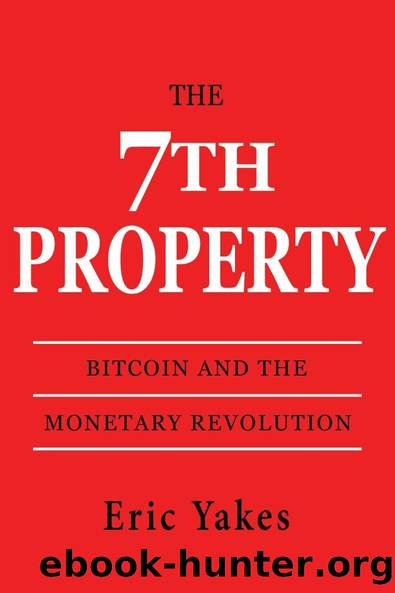The 7th Property: Bitcoin and the Monetary Revolution by Eric Yakes

Author:Eric Yakes [Yakes, Eric]
Language: eng
Format: epub
Tags: Bitcoin
Publisher: Black Poodle Publishing, LLC
Published: 2021-06-21T00:00:00+00:00
Digital Scarcity
Other attempts came and went, but what was common among them was their pegged value systems. What made your digital cash worth $100? Nobody had tried to implement a currency that maintained fundamental monetary properties. Instead, they were all tied to some other currency. In Digicash, you had to trade $100 to get 100 Digicash. Others did the same. NetCash attempted to get governments to authorize services to mint digital money out of thin air. E-Gold tried to 100% back their money in gold, and Digigold attempted to partially back it.3 Every idea was an attempt to peg the digital currency to the dollar or a commodity because attempting to bootstrap monetary value was a monumental task.
To create a free-floating digital money with monetary value, that digital money needs to maintain monetary properties. Recall the process of convergence in a market â step 1 for a good to become a monetary medium is to function as a valid store/cache of value. The most important property needed to achieve this is scarcity. Digital money is infinitely replicable, so making it scarce was a problem.
Achieving digital scarcity was ultimately done by using computational puzzles. The idea traces back to 1992 from cryptographers Dwork and Naor as a solution to email spam. If your computer must solve a puzzle that takes a few seconds every time you send an email, it would not really bother you but would significantly hinder a spammerâs ability to send thousands of spam emails per second. Adam Back implemented computational puzzles in his proposal for HashCash in 1997. Hal Finney, the first bitcoin recipient in history, has also been mentioned to have used computational puzzles in the first proof of work system.3 The proof of work system was ultimately used in bitcoin, requiring computers known as miners to solve a computationally intensive puzzle to create new bitcoins. This makes bitcoins costly to create and thus scarce. This will be discussed in detail in a later chapter.
Digital scarcity was solved by requiring computers to solve computationally expensive puzzles to create new digital money.
Download
This site does not store any files on its server. We only index and link to content provided by other sites. Please contact the content providers to delete copyright contents if any and email us, we'll remove relevant links or contents immediately.
International Integration of the Brazilian Economy by Elias C. Grivoyannis(99039)
The Radium Girls by Kate Moore(11975)
Turbulence by E. J. Noyes(7980)
Nudge - Improving Decisions about Health, Wealth, and Happiness by Thaler Sunstein(7659)
The Black Swan by Nassim Nicholas Taleb(7058)
Rich Dad Poor Dad by Robert T. Kiyosaki(6514)
Pioneering Portfolio Management by David F. Swensen(6257)
Man-made Catastrophes and Risk Information Concealment by Dmitry Chernov & Didier Sornette(5957)
Zero to One by Peter Thiel(5735)
Secrecy World by Jake Bernstein(4701)
Millionaire: The Philanderer, Gambler, and Duelist Who Invented Modern Finance by Janet Gleeson(4425)
The Age of Surveillance Capitalism by Shoshana Zuboff(4247)
Skin in the Game by Nassim Nicholas Taleb(4205)
Bullshit Jobs by David Graeber(4141)
The Money Culture by Michael Lewis(4135)
Skin in the Game: Hidden Asymmetries in Daily Life by Nassim Nicholas Taleb(3962)
The Dhandho Investor by Mohnish Pabrai(3725)
The Wisdom of Finance by Mihir Desai(3696)
Blockchain Basics by Daniel Drescher(3541)
